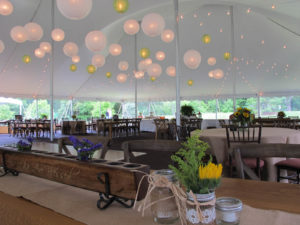
There are good reasons for a tent rental company to expand—or start to build—its inventory of non-tent event rental items.
A diverse inventory allows rental businesses to potentially provide clients with one-stop service. Then there’s the ability to broaden rental opportunities and serve new markets, which could help soften the financial hit delivered during the slow season.
This move may not be right for every rental business; some get along just fine focusing almost exclusively on tents. But for companies considering adding to their offerings, getting a handle on the items considered must-haves will make the endeavor more successful, particularly for smaller operations that can’t afford to carry a deep inventory or take on products that don’t reliably earn their keep. Rental essentials fall mostly into three categories: furniture, lighting and flooring, although many other accessories offer possibilities for add-on sales, depending on the local market.
Furniture: A sure thing
Tables and chairs require space and care, but these items are a relatively sure thing in terms of bringing in steady revenue, says Karen Alcock, partner at Classic Tents & Events in Norcross, Ga.
“You can’t possibly go wrong by having rounds, banquet tables and highboys in your inventory,” Alcock says. “To complement the tables, it’s easy to add chairs to the order. Clear acrylic ghost chairs are a hot item right now, although you want to be careful for an outdoor event because they could certainly become too hot.”
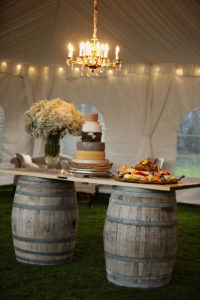
Tables and chairs are often the first items tent rental companies add to their inventory. Daryl Sensenig of Tents For Rent LLC, Lititz, Pa., says his company began building its inventory with tables and chairs. Both 60-inch rounds and 8-foot-long tables perform well; rectangle and farm-style tables are coming on strong for them, he says.
“We also have a high demand for all of our chair styles, except for the Chiavari ballroom chairs,” he says. “White and brown chairs are popular, and we’re increasingly getting requests for natural wood.”
Anything wood is “trending hot,” says Carol Cundey, marketing manager for Eureka! The Tent Company, a Binghamton, N.Y.-based tent manufacturer that also offers lighting and other accessories. She attributes this to the popularity of natural- and rustic-themed weddings. Farm tables, rustic bars and natural wood chairs are all in demand.
Phil Heidt, area manager for Seattle, Wash.-based CORT Party Rental, says his company’s Vineyard Collection of tables and chairs has proven so popular that it’s expanding the collection’s offerings to include wine barrel bars, lighting and more—all inspired by nearby wineries.
“Locally, our wine region is very popular,” Heidt says. “We look for ways to partner with and complement their beautiful venues. Also, we look to trends internationally and in larger markets that may work in our area. For example, rose gold has been popular in other regions and is just coming to the Seattle area.”
A chair to consider—one that may actually dethrone the Chiavari—is the cross-back farm chair, says Douglas Crowe, COO of Event Equipment Sales, a Chicago, Ill.-based supplier of event and hospitality products.
“If you haven’t invested into [this chair] yet, you’re missing revenue-generating opportunities,” says Crowe. “I think the perfect storm of variables provided this chair the ability to become the new option for rental companies. There are so many cross-back farm chairs in rental inventories across America, it’s officially here to stay.”
Crowe is also enthusiastic about his company’s Ultralight Series table, which is designed to counter some of the problems with wood-topped tables such as damaged corners from being dropped, delamination and UV and rain damage. The tables are 20 to 30 percent lighter than industry norms, don’t have a veneer top and are UV lacquered on both sides. Crowe believes these tables will become the industry standard in less than 10 years.
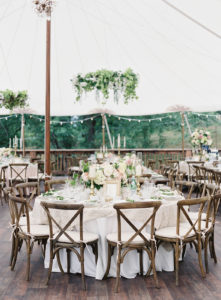
Lighting: Keep it simple
Lighting inventory has taken Blue Peak Tents Inc. of West Chicago, Ill., to “the next level,” says David Cesar, president. Café lighting is in strong demand, both inside and outside of tents, he says.
“We normally put our café lighting on dimmers so the client has complete control over their light output,” he says. “We’ve recently received many requests for overhead café lighting outside of tents. We’ve constructed new outdoor, self-standing poles where we can make unlimited configurations of outdoor café lighting areas.”
Heidt says his company uses café drop lights with Edison bulbs for outdoor lighting, either attaching these to something already installed or using their wine barrels with tall shepherd’s hooks to hang and drape an area—a look that is especially popular over dance floors and bars.
In keeping with the popular rustic and natural design schemes, Eureka!’s new Globe “Old Savannah” light sets and string lights are right on trend, Cundey says. “However, any type of lighting is always in demand,” she says. “Whether chandeliers, globe lighting, string lights and/or conventional PARs, adding soft white task lighting is essential for nighttime events.”
Sharon Mertens, sales manager for Tentwares Accessory Catalog in Manchester, N.H., says LED lights have become an important option because they require less power, stay cool to
the touch and are more efficient.
“Having the light bulbs also being plastic means no worrying about breakage,” she adds. “And you can save both time and labor in not having to replace or take out glass light bulbs after each event.” Chandeliers and Tentwares’ Ring Lights, designed to attach to tent center poles, are also trending.
Gobo lights have been a lucrative addition to the inventory at Classic Tents & Events, particularly for corporate events and weddings, says Alcock. These lights are easily branded with company logos or a wedding couple’s monogram. “It’s a fun and relatively inexpensive way to add drama and uniqueness to an event,” she says.
“We try to stay well within our level of expertise,” she adds. “We’re not lighting professionals so we don’t carry truss and spotlights, etc. If it’s something easy—such as plug-and-play LED lights—that we can add to our existing environment, then we’ll add it.”
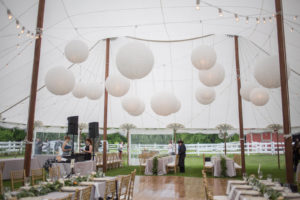
and café lighting are inventory must-haves
for rustic weddings. Photo courtesy of
Blue Peak Tents.
Floors and more
Flooring has also taken Blue Peak’s business up a notch, Cesar says. The company gets many requests for wood dance floors as well as for wood flooring for the entire tent. Flooring can prove lucrative for tent rental companies, although, as with lighting, caution
is required.
“The problem I see is that a lot of rental companies try to enter the flooring or lighting arenas but don’t have the right people or products to do it correctly,” Cesar says. “Or, because events are often short-term, I see many rental companies trying to cut corners with either the products or the installation.”
It’s important to match inventory with skill set and to invest in quality products, says Heidt, adding to this the need for safe and efficient storage. He says indoor/outdoor dance floors are fairly uncomplicated and can work either in tents or inside non-tented venues.
Flooring, draping and chandeliers are great upsells and are generally always in demand, Crowe says. “Not only are tenting companies able to recoup their investments on these items relatively quickly, they’re a great way to stay current with trends,” he says. Crowe recommends looking for products that are designed for easy installation and offer a customized look, such as EES’s Outlok® portable floor.
Other accessories to consider? Heating and air conditioning equipment can be critical for comfort, making them a good bet. Cesar also offers Schaefer fans, providing clients with a less expensive alternative to air conditioning a tent.
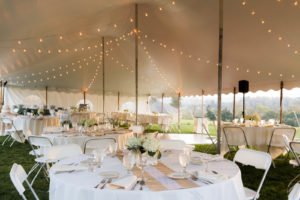
Yes or no
Still not sure if a particular item is right for your inventory? You have a few options before taking the plunge.
“You’ll want to run the numbers; how much you can rent the items for versus acquisition costs,” Cundey says. “Then, add in the total labor—or labor savings—you’ll actually need. In some cases, it might be better to subrent the items until you have enough rentals to cover acquisition costs. Or it may be more cost-effective to work out reciprocal agreements with local professionals.”
Heidt advises tent renters to consider how the new item might work with products already in inventory. Will your existing plate covers fit the new plate? Will a new chair style use the same protection covers as your other chairs? Heidt also suggests investigating if other nearby companies offer the same item, which can sometimes prove beneficial.
“We recently purchased eight misting units that another company in town also carries,” Heidt says. “Instead of investing in more for peak times, we can rent ours for 80 percent of the orders, then subrent to fill the peak times.”
And if you still don’t know, ask a supplier, Crowe says. “We’re more than happy to tell you what’s popular, what’s trending and what isn’t selling well.”
Pamela Mills-Senn is a Long Beach, Calif.-based freelance writer.
 TEXTILES.ORG
TEXTILES.ORG


